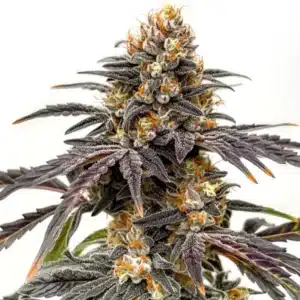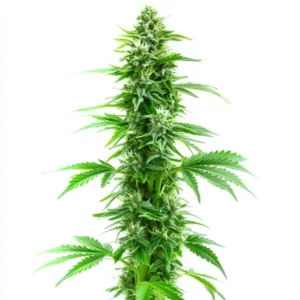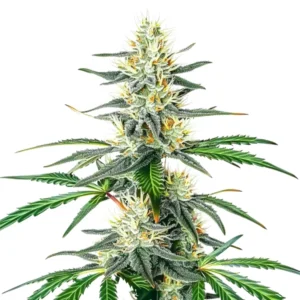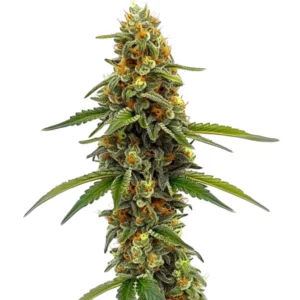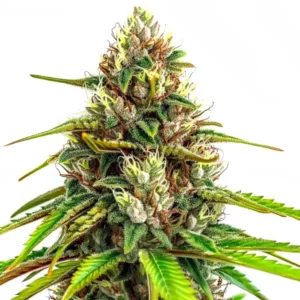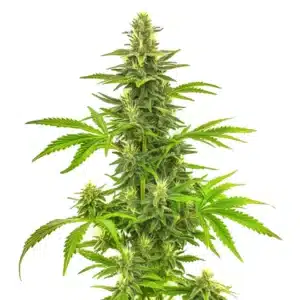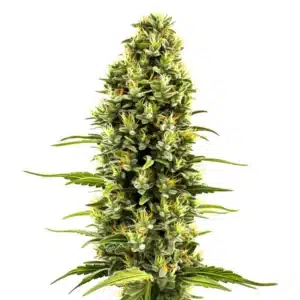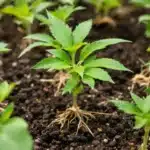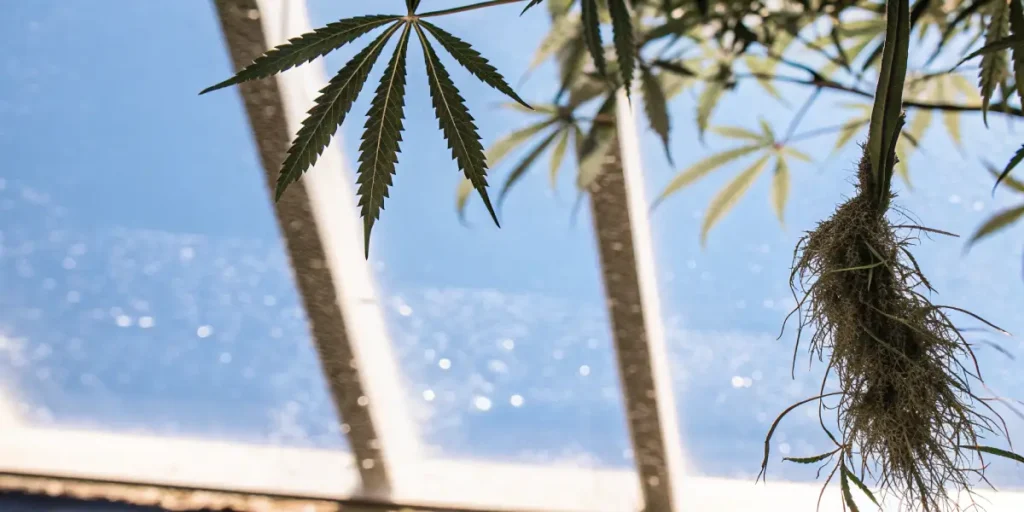
How Cannabis Absorbs Nutrients
Cannabis plants, much like humans, thrive on a balanced diet. They rely on a complex nutrient uptake process to grow healthy and strong. Knowing how cannabis absorbs nutrients can be the key to cultivating a thriving garden.
Roots are the main channels through which cannabis plants absorb nutrients. These roots, sprawling beneath the soil, act like straws sipping up nutrients dissolved in water. This process occurs at the root tips where tiny hairs increase the surface area for absorption.
Recommended Strains
Blue Dream
|
|
THC | 17% - 24% (Medium) |
|
|
Type | Feminized |
|
|
Yield | High |
|
|
Phenotype | 50% Indica / 50% Sativa |
Black Hulk
|
|
THC | 15% - 18% (Medium) |
|
|
Type | Feminized |
|
|
Yield | Medium |
|
|
Phenotype | 40% Indica / 60% Sativa |
In this guide, we delve into the nuances of how cannabis roots absorb nutrients. Whether you’re growing the potent Hulkberry or the flavorful Blue Dream, knowing nutrient absorption will help you optimize your yields.
The Cannabis Nutrient Uptake Process
The cannabis nutrient uptake process begins when roots encounter water containing dissolved nutrients. These nutrients, vital for plant growth, include nitrogen, phosphorus, and potassium, among others.
As roots absorb water, they also take in these nutrients. Tiny root hairs play a crucial role, maximizing contact with the nutrient-rich soil. This contact is vital for efficient nutrient absorption, ensuring your plants get what they need to thrive.
Knowing how cannabis absorbs nutrients involves recognizing the role of soil microorganisms. These microscopic allies break down organic matter, releasing essential nutrients in forms that are accessible to plant roots. This symbiotic relationship is crucial for the cannabis nutrient uptake process.
Furthermore, root exudates, which are compounds secreted by roots, can also influence nutrient availability. These exudates can alter the soil environment, encouraging beneficial bacteria and fungi that enhance nutrient absorption, thus demonstrating the complex interplay in how cannabis roots absorb nutrients.
Factors Affecting Cannabis Nutrient Absorption
Several factors can influence how effectively cannabis absorbs nutrients. Soil quality, water pH, and root health all play significant roles. Each element must be balanced to ensure optimal growth.
Soil quality is paramount. It should be rich in organic matter to support healthy root development. A well-aerated soil structure helps roots access nutrients more easily, promoting better growth.
Environmental conditions such as temperature and humidity can also affect how cannabis absorbs nutrients. Extreme temperatures can stress plants, altering their ability to take up nutrients efficiently. Maintaining an optimal climate is essential for maximizing cannabis nutrient absorption efficiency.
Another important factor is the presence of other plants or weeds. These can compete with cannabis for nutrients, reducing the overall availability. Regularly checking your garden for unwanted competitors can help in optimizing cannabis nutrient absorption.
Optimizing Cannabis Nutrient Absorption
To optimize cannabis nutrient absorption, focus on maintaining healthy roots. Regularly check the root zone for signs of distress, such as discoloration or wilting. Healthy roots are white and firm.
Use high-quality fertilizers designed for cannabis. These products often contain the right balance of nutrients to support plant growth. Avoid over-fertilizing, as this can lead to nutrient lockout, hindering absorption.
Besides to choosing the right fertilizers, consider incorporating organic compost or worm castings into your soil. These natural amendments improve soil structure and enhance how cannabis roots absorb nutrients by providing a steady supply of organic material.
Regular soil testing can also be invaluable. By knowing the current nutrient levels and pH, you can make informed decisions to adjust your growing conditions, ensuring that the cannabis nutrient absorption process remains efficient and effective.
Promos & Deals
Common Challenges in Cannabis Nutrient Uptake
One common challenge is nutrient lockout. This occurs when the soil’s nutrient levels are too high, preventing roots from absorbing any nutrients. Regularly flush the soil to prevent this issue.
Another issue is root rot, which can severely affect cannabis nutrient absorption efficiency. Ensure your growing medium has good drainage and avoid overwatering to keep roots healthy.
Pest infestations can also pose significant challenges. Insects like root aphids can damage the root system, impairing how cannabis absorbs nutrients. Regular inspections and appropriate pest control measures are crucial to maintaining healthy plants.
Furthermore, diseases such as powdery mildew can stress plants, indirectly affecting their ability to take up nutrients. Keeping a close eye on plant health and addressing any signs of disease promptly can help in maintaining efficient nutrient uptake.

Practical Tips for First-Time Growers
First-time growers should start with easy-to-grow strains like Blue Dream. These strains are forgiving and can tolerate minor nutrient imbalances.
Invest in a pH meter. Monitoring water pH can prevent nutrient deficiencies and lockout, ensuring your plants absorb nutrients effectively.
Educate yourself on the specific nutrient needs of the cannabis strain you are growing. Different strains may have varying requirements, and understanding these can enhance your cannabis nutrient uptake process.
Document your growing process. Keeping detailed records of watering schedules, nutrient feedings, and plant observations can help you identify patterns and make adjustments for optimizing cannabis nutrient absorption over time.
FAQs on Cannabis Nutrient Absorption
How can I tell if my cannabis plant is absorbing nutrients properly?
Look at your plant’s leaves. Healthy plants have vibrant green leaves. Yellowing or browning can indicate nutrient deficiencies or lockout. Growth rate is another good indicator. If your plant is growing steadily, it’s likely absorbing nutrients well.
Regularly check the root zone. Healthy roots are crucial for nutrient absorption. They should appear white and firm. If they look brown or mushy, your plant might be struggling with nutrient uptake.
Monitoring growth patterns can also provide insights. Sudden changes in leaf shape or size may suggest issues with how cannabis absorbs nutrients. Consistent and balanced growth is a positive sign of effective nutrient uptake.
Additionally, using a nutrient deficiency chart can help diagnose specific issues. By matching symptoms to possible deficiencies, you can make targeted corrections to support optimal cannabis nutrient absorption.
What are the signs of nutrient lockout in cannabis plants?
Nutrient lockout can cause leaves to yellow or develop brown spots. You may also notice stunted growth or wilting. This condition occurs when excess nutrients prevent roots from absorbing any more.
To fix nutrient lockout, flush your plants with pH-balanced water. This helps remove excess nutrients from the soil, allowing roots to begin absorbing nutrients again.
Another sign of nutrient lockout is the buildup of salts on the soil surface. This can be an indicator that it’s time to flush your soil to restore balance and improve how cannabis roots absorb nutrients.
Regularly testing soil runoff can also help detect and prevent nutrient lockout. By checking the pH and electrical conductivity, you can adjust your feeding regimen and maintain efficient cannabis nutrient absorption.
Is it necessary to adjust water pH for cannabis plants?
Yes, adjusting water pH is essential for cannabis nutrient uptake. Cannabis absorbs nutrients best in slightly acidic conditions, around a pH of 6. Water that is too acidic or alkaline can hinder nutrient absorption.
Use a pH meter to test your water regularly. Adjust the pH using commercially available products to keep your plants healthy and ensure efficient nutrient uptake.
Besides to water pH, consider the pH of your growing medium. Soil and hydroponic systems may require different adjustments to optimize cannabis nutrient absorption efficiency.
Changes in pH can occur over time, especially in recirculating hydroponic systems. Regular monitoring and adjustments will help maintain the ideal conditions for how cannabis absorbs nutrients.
Can overwatering affect how cannabis absorbs nutrients?
Overwatering can severely affect nutrient absorption. It can lead to root rot, which diminishes the root’s ability to absorb nutrients. Always allow the top inch of soil to dry out before watering again.
Ensure your pots have good drainage. Poor drainage can lead to waterlogged soil, further complicating nutrient absorption and increasing the risk of root diseases.
Besides to root rot, overwatering can cause oxygen deprivation in the root zone. Roots require oxygen to function properly, and waterlogged conditions can impair how cannabis roots absorb nutrients.
Consider using soil moisture meters to guide your watering practices. These tools can help you avoid overwatering and maintain optimal conditions for efficient cannabis nutrient absorption.
Why are root health and structure important for nutrient absorption?
Roots are the primary site for nutrient uptake. A healthy root system efficiently absorbs nutrients, while damaged roots struggle. Keeping roots healthy should be a top priority for any grower.
Avoid damaging roots during transplanting and check them regularly. Healthy roots are a foundation for a strong, productive cannabis plant, enabling optimal nutrient uptake and growth.
The architecture of the root system also plays a role in nutrient absorption. A well-developed network of roots increases the surface area available for nutrient uptake, enhancing how cannabis absorbs nutrients.
Incorporating practices such as gentle root pruning can stimulate new growth, leading to a more robust root system and improved cannabis nutrient uptake process.



